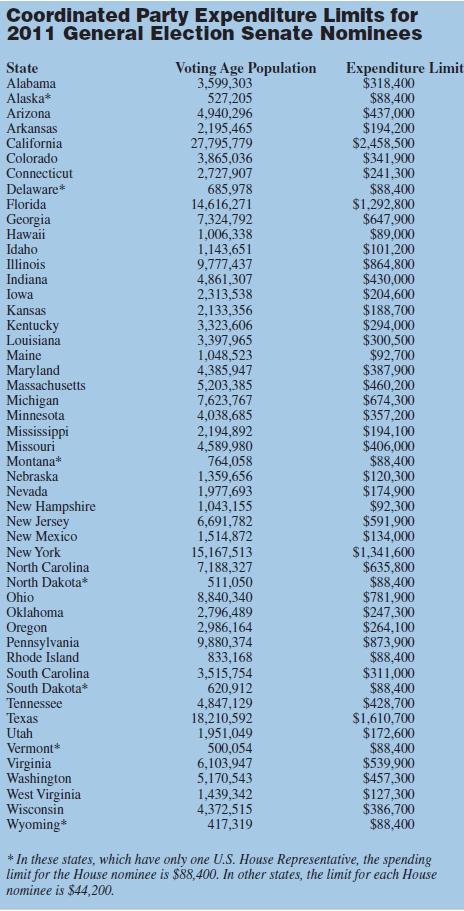2011 Coordinated party expenditure limits
The 2011 coordinated party expenditure limits are now available. The limits are:
- $88,400 for House nominees in states that have only one U.S. House Representative;
- $44,200 for House nominees in states that have more than one U.S. House Representative; and
- A range from $88,400 to $2,458,500 for Senate nominees, depending on each state’s voting age population.
Party committees may make these special expenditures on behalf of their 2011 general election nominees. National party committees have a separate limit for each nominee. [FN1] Each state party committee has a separate limit for each House and Senate nominee in its state. Local party committees do not have their own separate limit. One party committee may authorize another committee of that party to make an expenditure against the authorizing committee’s limit. Local committees may only make coordinated party expenditures with advance authorization from another committee within the party.
Coordinated party expenditure limits are separate from the contribution limits; they also differ from contributions in that the party committee must spend the funds on behalf of the candidate rather than give the money directly to the campaign. Although these expenditures may be made in consultation with the candidate, only the party committee making the expenditure—not the candidate committee—must report them. (Coordinated party expenditures are reported on FEC Form 3X, line 25, and are always itemized on Schedule F, regardless of amount.)
The accompanying tables include:
- Information on which party committees have the authority to make coordinated party expenditures;
- The formula used to calculate the coordinated party expenditure limits; and
- A listing of the state-by-state coordinated party expenditure limits.
Authority to make coordinated party expenditures on behalf of House and Senate nominees
| National party committee | May make expenditures on behalf of House and Senate nominees. May authorize [FN1] other party committees to make expenditures against its own spending limits. National Congressional and Senatorial campaign committees do not have separate limits. |
|---|---|
| State party committee | May make expenditures on behalf of House and Senate nominees seeking election in the committee’s state. May authorize* other party committees to make expenditures against its own spending limits. |
| Local party committee | May be authorized* by national or state party committee to make expenditures against its limits. |
*The authorizing committee must provide prior authorization specifying the amount the committee may spend.
Calculating 2011 coordinated party expenditure limits
| Amount | Formula | |
|---|---|---|
| Senate nominee | See table of limits | The greater of: $20,000 x COLA or 2¢ x state VAP* x COLA** |
| House nominee in States with only one representative | $88,400 | $20,000 X COLA |
| House nominee in other States | $44,200 | $10,000 X COLA |
| Nominee for Delegate or Resident Commissioner*** | $44,200 | $10,000 x COLA |
*VAP means voting age population.
**COLA means cost-of-living adjustment. The applicable COLA is 4.42246.
***American Samoa, the District of Columbia, Guam, the Virgin Islands and the Northern Mariana Islands elect Delegates; Puerto Rico elects a Resident Commissioner.

FOOTNOTE:
1 The national Senatorial and Congressional committees do not have separate coordinated party expenditure limits, but may receive authorization to spend against the national limit or state party limits.